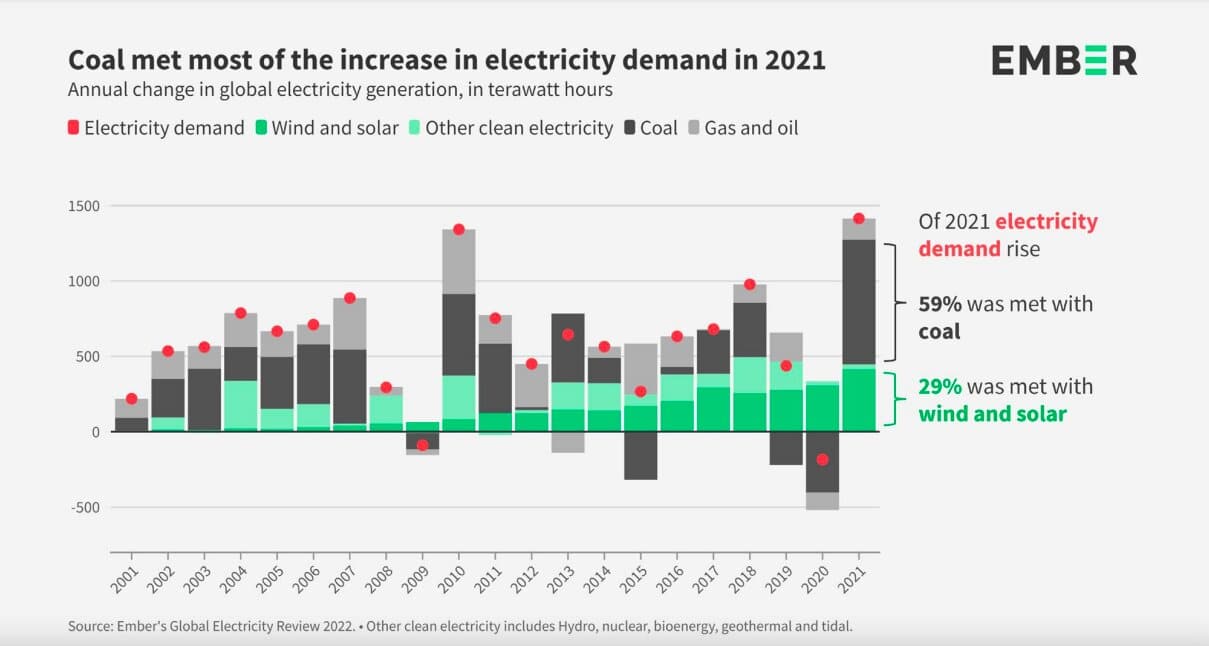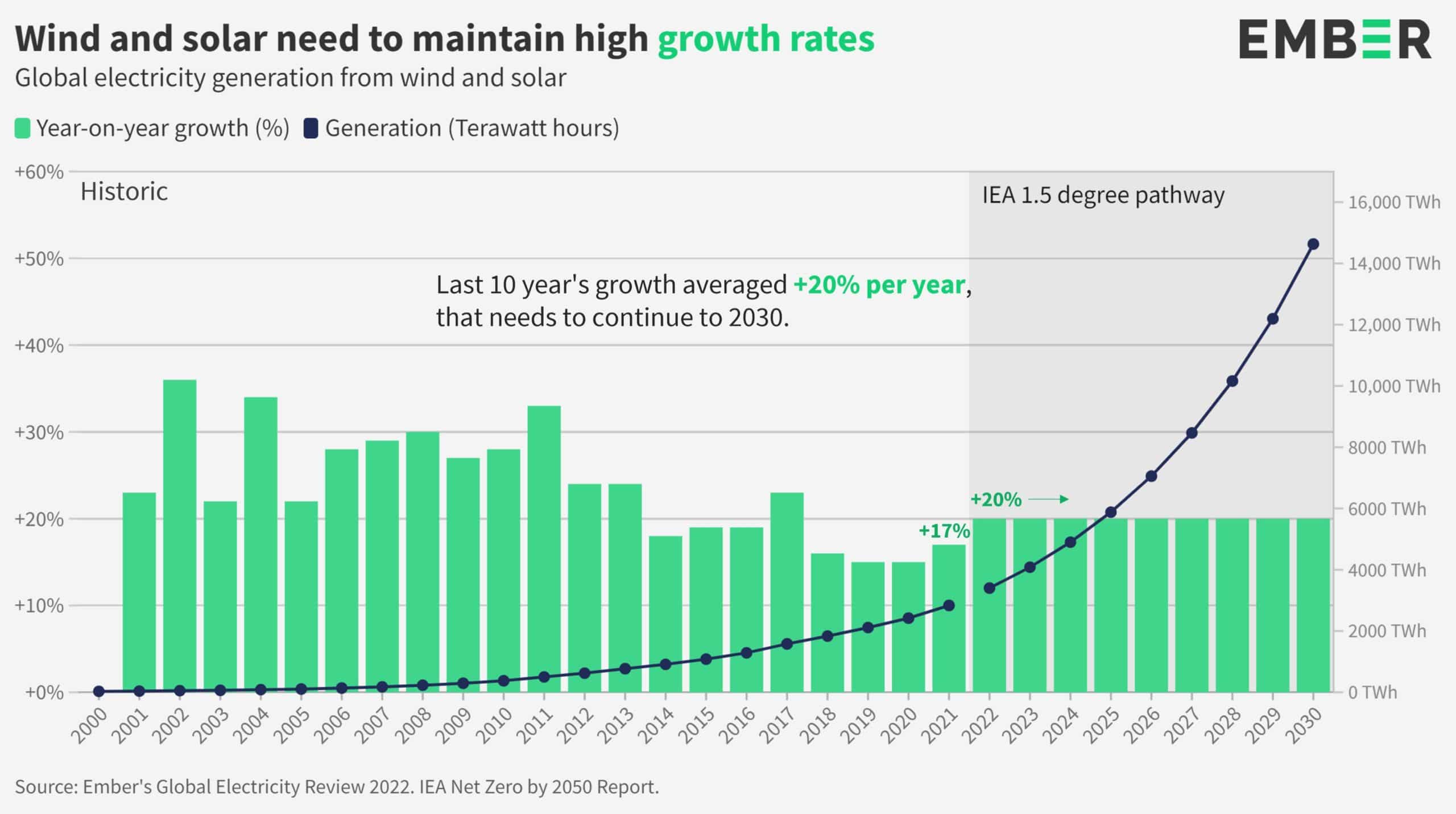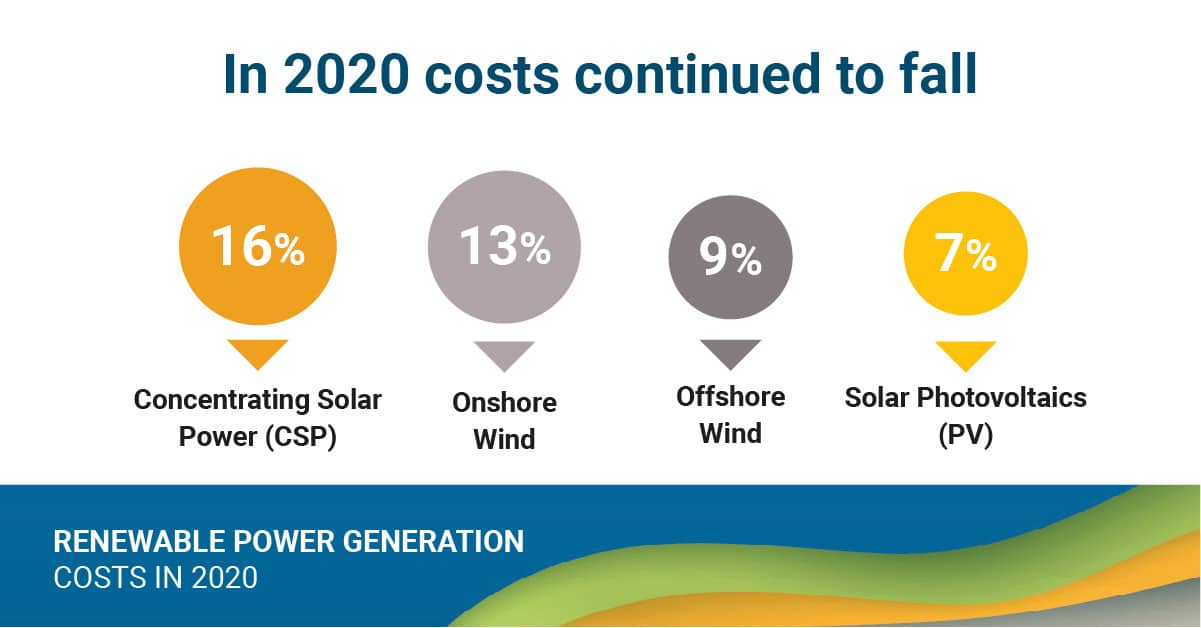Renewables are inexhaustible sources of energy. Unlike fossil fuels, the production of which requires huge efforts, time, and expensive heavy machinery, they convert a natural resource – like sun, wind, water, or biomass – directly into electricity. Another big factor that makes renewable energy much more attractive than coal, oil, and natural gas is their significantly smaller environmental footprint. Renewables are not only cleaner but also cheaper and easier to produce than any fossil fuel. Here are 7 interesting renewable energy facts about the current state of the market and what role these clean sources will play in the future.
—
7 Renewable Energy Facts That Will Blow Your Mind
1. Renewable Energy Sources Generated 38% of Global Electricity in 2021
In 2021, all mainstream clean energy sources – hydroelectric, solar, wind, biomass, and geothermal– generated a combined 38% of the world’s electricity, marking a record year for clean energy sources. They surpassed the amount of energy produced from coal – which stopped at 36.5% in the same year despite a record 9% rise, the fastest yearly growth in coal energy generation since 1985.
Nevertheless, the vast majority of global electricity still came from non-renewable sources. In 2021, global electricity demand grew by 5.4%, the biggest increase since 2010. Despite a record rise in wind and solar power generation, clean electricity has not been deployed quickly enough to keep up with the rapid increase of global demand, most of which was met once again by fossil fuels. Coal generation alone accounted for 59% of the total rise. This, experts argue, shows how far off-track the electricity transition is.

Share of Global Electricity Demand, 2021. Image: Ember.
2. Wind and Solar Are the Fastest-Growing Renewables
In 2021, the fastest-growing sources of clean energy were wind and solar, whose share doubled since the Paris Agreement was signed in 2015. Within just one year, the latter rose by 23% from 2020 levels, while electricity generated by wind turbines experienced a 14% increase. For the first time, solar panels and wind turbines generated over 10% of the global electricity demand. According to research by Ember, these two clean energy sources experienced an average of 20% compound growth per year. In order to meet the 1.5C pathway by 2030, Ember’s researchers argue, such high growth rates need to be maintained throughout the current decade.

Wind and Solar Energy Growth Rates, 2000-2030. Image: Ember.
3. Wind and Solar Power Production in EU Hits Record Amid Energy Crisis
The European Union hit a record 12% in solar power production from May to August 2022, and 13% from wind. What’s more, 19 of the bloc’s 27 member states have achieved record wind and solar power generation since March of this year. The growth in renewable energy capacity has saved the EU approximately €99 billion (US$97 billion) in avoided gas imports between March and September, the report found.
The statistics were revealed in the 2022 State of the Energy Union report, published yesterday by the European Commission. Data suggests that the bloc managed to increase its share of renewables in the electricity mix to 43% in the second quarter of 2022, outplaying fossil fuels, which stopped at 36%. Poland saw the greatest increase in renewables (48.5%) between March and September compared to last year.
You might also like: What Are the Advantages and Disadvantages of Solar Energy?
4. 98.4% of Norway’s Energy Comes From Renewable Sources
Norway is by far the largest clean energy producer, followed by Brazil with 84.1% and New Zealand with 80%. 50 countries have now crossed the 10% wind and solar mark, with seven new countries doing so in 2021 alone: China, Japan, Mongolia, Vietnam, Argentina, Hungary, and El Salvador. The fastest switch to wind and solar took place in the Netherlands, Australia, and Vietnam. All three nations managed to shift over 8% of their total electricity demand from fossil fuels to wind and solar between 2020 and 2021. Vietnam alone experienced unprecedented growth in solar energy, which grew by over 300% in a single year.
Lacking far behind are Asian countries like China and India. Despite China contributing the biggest growth in solar and wind energy capacity in the past few years, it has also experienced a record rise in coal in 2021 for the fifth year in a row. China was the only country to significantly increase nuclear power production. Similarly, India is also big on fossil fuels: it is the world’s second-largest coal power generator and relies on this energy source to cover 74% of its total electricity demand.
5. Renewables Are Getting Cheaper
According to the International Renewable Energy Agency (IRENA), renewables were the world’s cheapest energy source in 2020. The Agency’s latest report showed that the cost of renewable technologies – especially concerning wind and solar energy – is falling significantly. The rapid drop in costs of these technologies in recent years has enabled countries around the world to increase their renewable energy production capacity. This, coupled with high fossil fuel prices, improves the competitiveness of these two renewable sources further.

Costs of Renewable Power Generation, 2020. Image: IRENA.
In its World Energy Outlook 2020 report, the International Energy Agency (IEA) confirmed that solar power schemes now offer the cheapest electricity in history and predicted that by 2050, renewable energy generation will keep growing, with solar power production skyrocketing and becoming the world’s primary source of electricity. Solar energy is indeed praised for the relatively marginal operation and maintenance costs of panels. In 2020, the average cost of solar photovoltaics – once considered a financial burden – was 7% less than the previous year. Furthermore, the cost of large-scale solar projects has plunged 85% in the past decade, and those of concentrating solar power (CSP) – an approach to generating electricity through mirrors – dropped by 16% in 2020.
Similarly, wind power is also experiencing rapidly declining costs. In 2020, onshore wind power dropped by about 13% while offshore wind costs decreased by about 9%. With the IEA estimating that costs of wind power could drop by as much as 40% over the next decade based on current technology and market growth, projected offshore wind energy has the potential to generate 425,000 TWh of electricity in a year worldwide, which is more than 18 times the current global electricity demand. Likewise, onshore wind energy capacity is projected to increase by 57% by 2024.
6. Renewables Are Carbon-Smart Energy Sources
Renewable energy sources are one of our greatest allies in the race to reach net-zero emissions because of their low carbon dioxide emissions in comparison to fossil fuels. Indeed, wind, solar, hydroelectric, and geothermal electricity all have a particularly low environmental footprint throughout their life cycles.
Notably, the solar life cycle generates minimal greenhouse gas emissions coming mainly from photovoltaic (PV) modules and other components, as the materials they are made of are mined and processed. Similarly, some emissions do occur during the wind power lifecycle including the building and construction of turbine towers. The making of materials used in the turbines such as steel, concrete, fiberglass, and copper all produce some greenhouse gases. However, in both cases, total emissions are significantly lower than those generated by coal and natural gas-fired power plants, which account for three-quarters of global greenhouse gas emissions. As for geothermal energy, power plants can meet the most stringent clean air standards, as they emit little carbon dioxide, very low amounts of sulfur dioxide, and no nitrogen oxides. It is estimated that the average global CO2 emission of geothermal power plants is 122 g/kWh, about 10 times less than coal and petroleum.
7. Renewables on Track to Become Largest Source of Global Electricity by 2025
Renewable energy will become the largest source of global electricity generation by 2025 and by 2027, the world will have twice as much renewable capacity as in the previous five years, the International Energy Agency (IEA) said. According to the Agency, the global energy crisis has triggered an “unprecedented momentum” in the renewable sector, forcing countries to find alternatives to replace increasingly expensive fossil fuels and speed up the development of solar, wind, and other clean power sources.
Future Outlook on Renewable Energy
According to the latest IPCC climate report, we have all the tools and options to halve emissions in all sectors by 2030, and renewables are one of them. These low-cost, low-emission, infinite natural resources have the potential to pave the way for the world to reach a net-zero scenario by 2050. The IEA’s 1.5C pathway shows wind and solar as the powerhouse of clean electricity, providing three-quarters of all new clean electricity to become 40% of the world’s electricity by 2030.
There should be no more delays to transition to 100% clean energy and it requires all nations around the world – especially developing countries – to increase investments in renewables and step up efforts to facilitate the transition to clean power. The Agency predicts that emerging economies will have to increase their annual clean energy investments from less than USD$150 billion in 2020 to over USD$1 trillion by 2030 if we want to be on track to achieve carbon neutrality. Nevertheless, fossil fuels still account for the majority of global electricity and while renewable capacity additions are set to grow the fastest in the coming five years, the expansion trend is not on track to meet the net-zero scenario by 2050.
You might also like: What the Future of Renewable Energy Looks Like


















